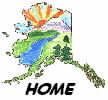(One of Alaska's nicknames)
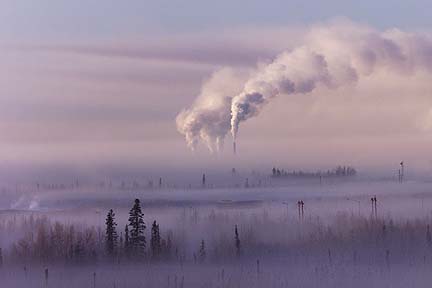
Ice fog enshrouds Fairbanks Wednesday, Jan. 27, 1999, as temperatures dropped to near 40 below. The exhaust stacks rise from the Aurora Energy power plant on First Avenue. (Photo by Sam Harrel) The above photo was reprinted with permission (in degraded form), from the Fairbanks Daily News-Miner's website "photoalbum" for January 30-February 5, 1999.
Human Popcicles?
Here are some pictures in and around Fairbanks, AK when the ambient temperatures are in the -40s and -50s. Just for the record, -40 is the same on both C and F scales and does not include "wind chill" **see footnote!**. (Metal touching bare skin--bad idea!)
Picture downtown, -55F. The ice fog is bad here, but can be worse. Visibility here I would guess to be less the 1/4 mile. When a car is infront of you at a stop light, their exhaust freezes into a huge cloud when they accelerate. You have to wait for the visibilty to return before you can go.
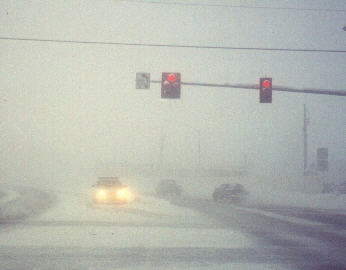
A clear picture from above the ice fog shows just how the concentration of people increases the ice fog. Note that it is contained below an inversion layer. Really cold air is held against the ground by slightly "warmer" air above. You can see two plumes of smoke, one on each side of the picture. These are from the city and university power plants, from left to right.
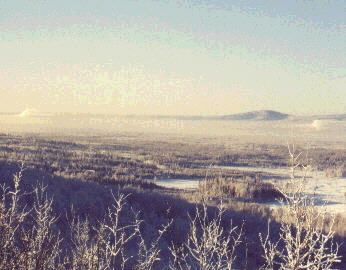
Temps this day had warmed up to a balmy -40F after sticking for two weeks in the -60s. (Remember: 40 below is 40 below, F or C scales!) Alaskans still go in the real cold weather, but usually save the non-essential errands for the "warmer" weather. Here you see the combination of ice fog, exhaust plumes from running cars and the temperature. Doesn't this picture just look cold?
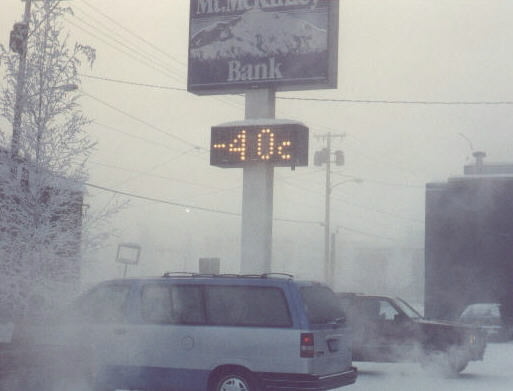
For entertainment, you can make clouds by heating water (like coffee hot) and toss it in the air. If it is cold enough (like here @ -55F) all the water will evaporate. Nothing hits the ground. Now that is fun.
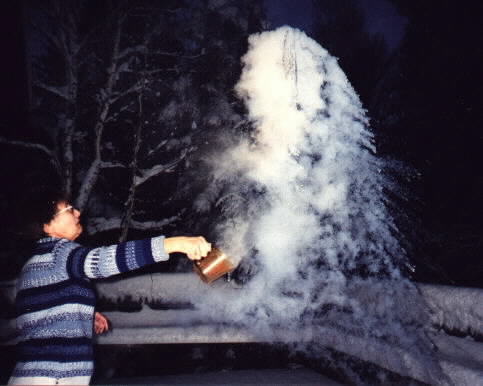
For a second (independent) opinion on the winter weather see
"Life at 50 Below."
The below figure shows the temperature trends observed in Fairbanks,Alaska a couple of winters ago. I copied this (and the next 2 graphs) from the University of Alaska Fairbanks' Geophysical Institute.
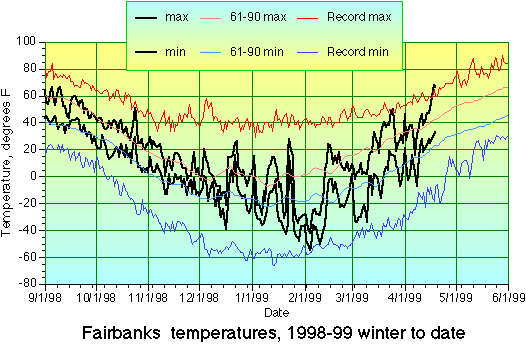
|
Fairbanks' sunrise-sunset duration varies considerably as the year moves along. Below you can see the variation from just over 3 hours and 40 minutes, to 22 hours of sunshine. Of course the quality of sun light varies along with the quantity, from dusk (low angle winter) to 24 hours around June 21. Check today's sunrise/sunset data.
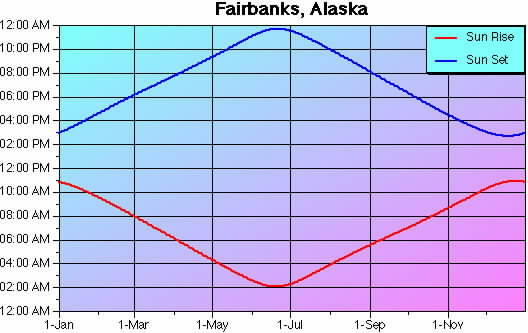
Here is a multi-exposure picture of the Winter Solstice. All 3 hours, 42 minutes of daylight can be captured with one lens looking south!

Point Barrow, the northern-most settlement in Alaska, has a period between mid-November and mid-January where the sun does not rise! But 24 hours of sun during the brief high arctic summer. This explains the strange looking graph below:

So what do you do when it gets this cold and dark? Get out of town and the fog and go ice fishing....

Or, you can just go CRAZY!!

**FOOTNOTE: Current research indicates that the Antarctic studies establishing the windchill scale OVER ESTIMATE the degree of coldness by 8 to 15 degrees F. Therefore, we conclude what has been known by Northerners all along: -20 wind chill is not anywhere close to real, ambient -20. Heck, your nose hairs won't even freeze! Just thought you should know.
Index of Alaska Pictures
